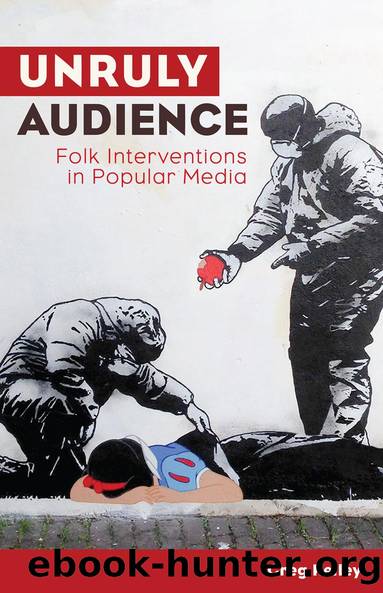Unruly Audience by Greg Kelley

Author:Greg Kelley [Kelley, Greg]
Language: eng
Format: epub
ISBN: 9781607329893
Barnesnoble:
Publisher: Utah State University Press
Published: 2020-09-21T00:00:00+00:00
Meme-ing TWSS
Google searches for the phrase TWSS spiked notably in 2009â10, corresponding almost exactly to the run of season 6 of The Office, and I think we can extrapolate that the showâs accumulation of TWSS references over the years reached a sort of tipping point by then that launched the phrase generally into the popular consciousness. That, and the extensive repetition of this folklore form across the digital landscape, sent it on its way to becoming a bona fide media meme. The application of biological meme theory to folkloristics is certainly not without its quandaries. In the fullest scholarly treatment on the subject, Elliott Oring (2014a, 2014b) thoroughly interrogates precedent studies of memetics and folkloristics by Pimple (1996), Zipes (2008, 2011b), Ellis (2003, 75â97), and Heath, Bell, and Sternberg (2001). Oring is especially critical of earlier tautological formulations claiming that memes demonstrate âfitnessâ simply by dint of their continued replication; in the end, he remains skeptical as to the value of memetics theory for cultural analysis because, he argues, the operative principle of selection in cultural dissemination has not been conclusively demonstrated.
Oringâs discussion focuses primarily on nonmediated cultural forms, however. Once the consideration broadens to include the wider expanse of electronic communicationâbroadcast media, the internet, digital social networkingâthe possibilities for proliferation, and therefore evolutionary selection, would seem greater, albeit still difficult to measure. While descriptions of media memes as âself-replicatingâ are flawed, as they fail to account for human agency in the production and dissemination of culture, the conceptual notion of the meme does provide âa compelling way to understand the dispersion of cultural movements,â Jenkins, Ford, and Green accept, âespecially when seemingly innocuous or trivial trends spread and die in rapid fashionâ (2013, 19). Complexities arise when the supposed replicating âselfish genesâ meet social selves (Haig 2020). Within those larger questions about why certain instances of folklore (face-to-face, mediated, or otherwise) multiply while others go extinct (Oring 2014a, 473), I would suggest that the TWSS joke replicated effusively, and remained robust for a period, partly as a function of its brevity and relatively stable form.
It should be noted here that there is a distinction to be made between virals and memes. The difference lies in variability, notes Limor Shifman. Virals are single cultural units (videos, photos, or jokes, e.g.) that proliferate in numerous copies, while internet memes are comprised of collections of remixed, mashed-up, and repurposed texts (2014, 56). In that regard, then, TWSS jokes qualify as both virals and memes. The four-word TWSS text presents low variability, disseminated virally as it is in a consistent, compact verbal form. But the truncated (and therefore easily transmitted) jocular phrase is embedded in wide varieties of conversational and/or visual contexts, whose meanings then shift toward the salacious as a result. So as a rhetorical device, the TWSS tagline is transformative, retroactively refiguring benign antecedent discourse into extended dirty joke telling. There is something of a balancing act here, struck between adherence to the established patterns of the meme and creative innovation in novel expressions of it (see Nissenbaum and Shifman 2017, 493â94; Milner 2013).
Download
This site does not store any files on its server. We only index and link to content provided by other sites. Please contact the content providers to delete copyright contents if any and email us, we'll remove relevant links or contents immediately.
Cecilia; Or, Memoirs of an Heiress — Volume 1 by Fanny Burney(32022)
Cecilia; Or, Memoirs of an Heiress — Volume 3 by Fanny Burney(31436)
Cecilia; Or, Memoirs of an Heiress — Volume 2 by Fanny Burney(31380)
The Great Music City by Andrea Baker(30640)
We're Going to Need More Wine by Gabrielle Union(18605)
All the Missing Girls by Megan Miranda(14588)
Pimp by Iceberg Slim(13717)
Bombshells: Glamour Girls of a Lifetime by Sullivan Steve(13665)
Fifty Shades Freed by E L James(12886)
Talking to Strangers by Malcolm Gladwell(12813)
Norse Mythology by Gaiman Neil(12782)
For the Love of Europe by Rick Steves(11331)
Crazy Rich Asians by Kevin Kwan(8860)
Mindhunter: Inside the FBI's Elite Serial Crime Unit by John E. Douglas & Mark Olshaker(8663)
The Lost Art of Listening by Michael P. Nichols(7125)
Enlightenment Now: The Case for Reason, Science, Humanism, and Progress by Steven Pinker(6852)
The Four Agreements by Don Miguel Ruiz(6283)
Bad Blood by John Carreyrou(6252)
Weapons of Math Destruction by Cathy O'Neil(5800)
